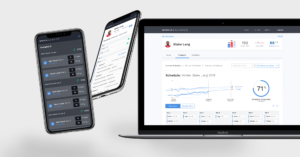Sparta Science Focusing on Injury Prevention Through Technology
The tech company has deals in place across the NBA, MLB and the NCAA
Posted On: February 26, 2021 By :
Injuries have been a prevelant topic for any sports league during the coronavirus pandemic. Between shortened offseasons in the NBA and teams at all levels having to start and stop because of contact tracing issues, many teams have seen a spate of muscle injuries and assorted other issues that come with not having a regular schedule of practice and injury maintenance.
For any professional or college organization, challenges exist to make sure an injured athlete is fully healthy after an injury. Teams must also maintain health and safety protocols that may mean little if any close contact — especially if a player is on a guaranteed contract.
Now at least one product exists to help fill that gap.
Sparta Science was created by Dr. Phil Wagner as a passion project. Wagner is a former collegiate athlete who sustained injuries during his athletic career and was frustrated with the guesswork that can come with rehabilitation. The Sparta system uses force place machine learning and a series of jump and balance tests to understand player baselines, predict injury risks and provide benchmarks for recovery.
“If you’ve ever been in physical therapy, a lot of it is just subjective guessing,” Wagner said. “I felt there was a huge opportunity to solve that problem and help people not only participating in activities without getting hurt, but if they do get hurt how they can return safely.
“I think everybody recognizes that there’s a big problem — we have more data than ever, more information and we also have more injuries,” he said. “So what are we learning from all this stuff?”
Teams Sign on to Program
Sparta Science uses Force Plate Machine Learning with a two-minute scan that can help prevent injuries and predict an athlete’s readiness. Among the teams Sparta Science supports are the Cleveland Cavaliers, Washington Football Team, Pittsburgh Steelers, Colorado Rockies, Portland Timbers and dozens of colleges and universities including Clemson, Ohio State, Auburn, Texas, Oklahoma and UCLA. The collegiate landscape is one that Wagner feels specifically can see the greatest gains from the technology.
“The professional realm is very transient and the stakes are higher so there’s a lot more turnover,” Wagner said. “I think colleges really have the opportunity to lead because players are there for an extended period of time and the athletes are younger so they can build better habits.”

Sparta’s focus is to fix one of three common issues: Individuals who are injured and don’t know when they can return to action safely without an increased risk of re-injuring themselves; young players who want to make sure they have proper movement and their career longevity is preserved; and for professional organizations ability to identify potential replacements during offseason roster movements and to know if they are a good fit physically.
With any technology that involves a person’s physical health and measurements, there are also privacy concerns that have to be addressed.
“That’s a tricky one, right?” Wagner said. “The team, ultimately their goal should be aligned with the athletes and how they can work together looking at information to be able to put together the best plan for that individual’s success. The best example is if there’s player movement between organizations, whether that’s college or pro, that’s where the information sharing is critical because history is the most important factor in predicting somebody’s outcome. For that to happen, the individual data has to be shared with the organization so the best decisions can be made for everyone involved in the outcome.”
Posted in: Coronavirus, Latest News, Sports Organizations, Technology in Sports